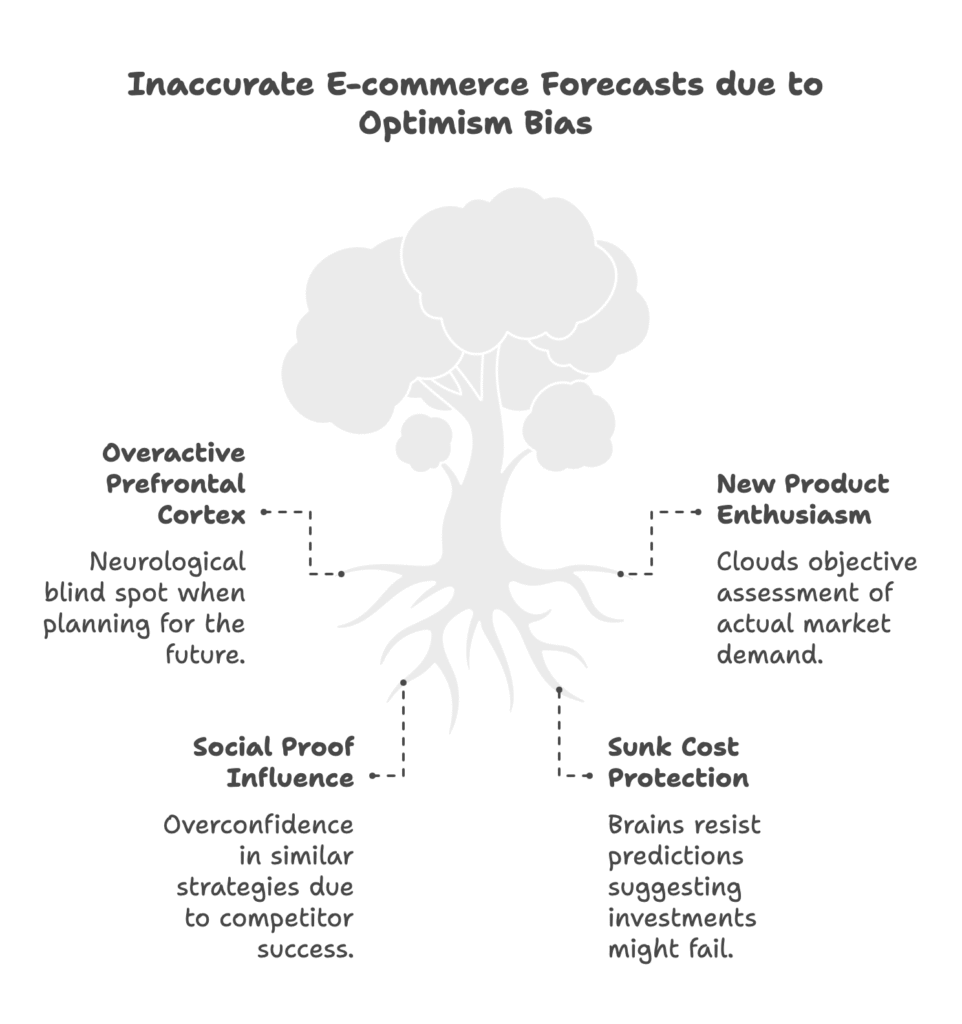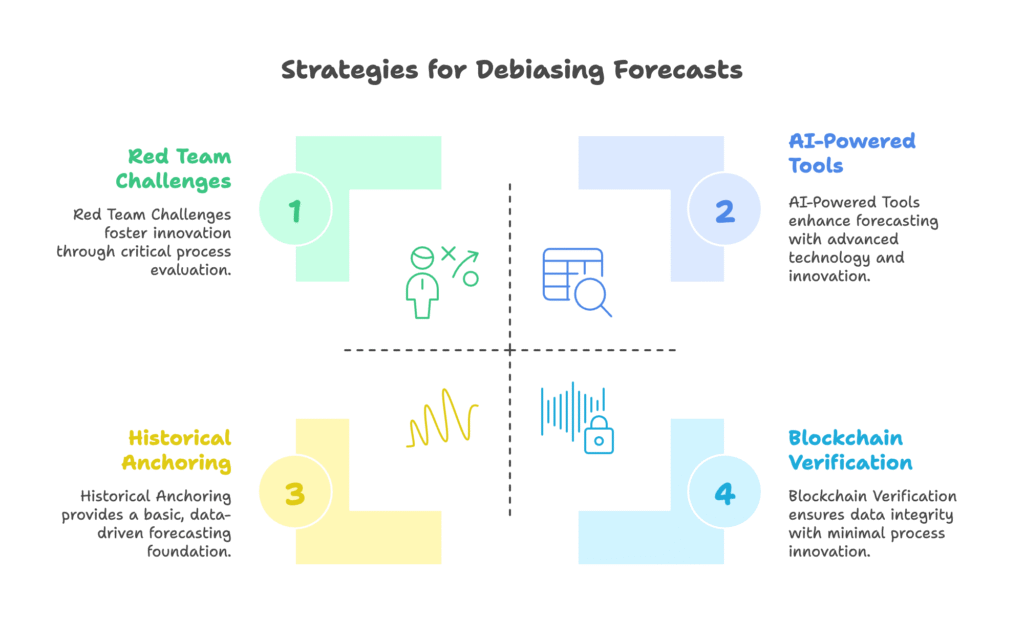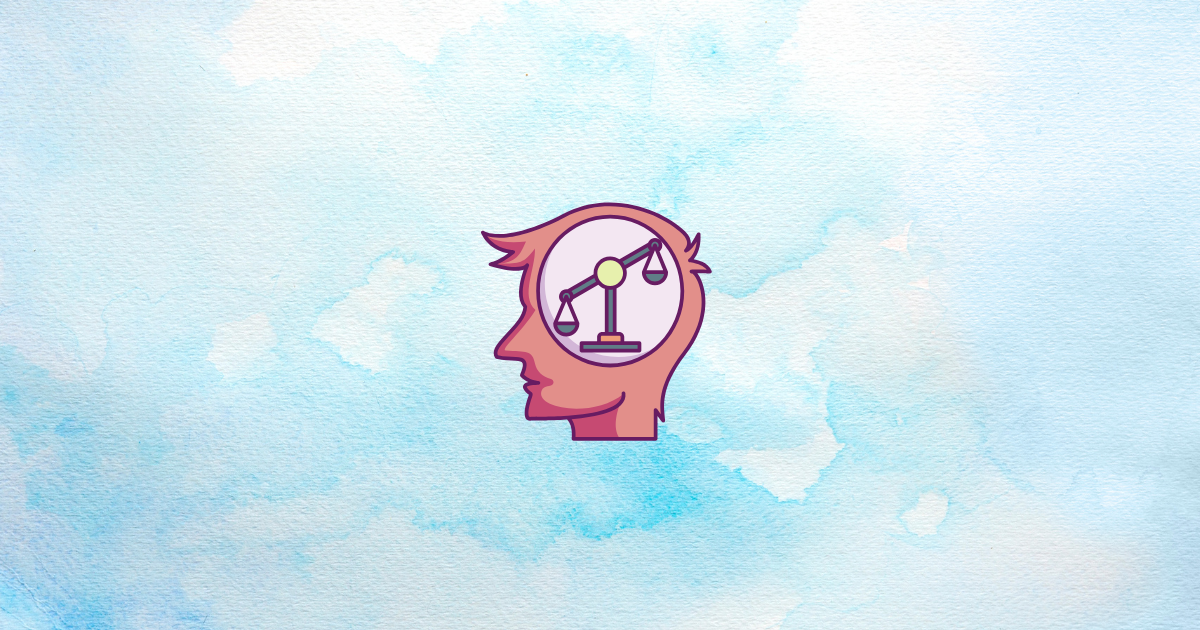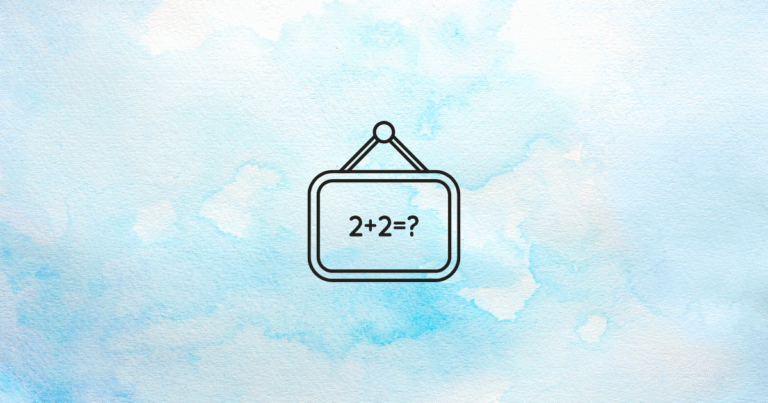Ever caught yourself thinking, “This product launch is going to crush it!” only to see mediocre sales trickle in? Or perhaps you’ve stocked up on inventory for a “guaranteed bestseller” that’s now collecting dust in your warehouse? If so, you’re not alone—you’ve just experienced optimism bias, a cognitive blind spot that affects a staggering 80% of e-commerce professionals.
Your brain is actually wired to see the future through rose-colored glasses. It’s a trait that kept our ancestors motivated through harsh winters, but in today’s data-driven Shopify ecosystem, it can lead to costly mistakes and missed opportunities. The good news? You can train your brain to make more accurate predictions while still maintaining the positive energy that drives your business forward.
In this article, you’ll discover the hidden psychology behind your forecasting errors, learn exactly how this bias is costing you money, and master practical techniques to balance optimism with accuracy. Ready to transform your marketing forecasts from wishful thinking into reliable business tools? Let’s dive in!
Understanding Optimism Bias in E-Commerce
Before we can overcome optimism bias, we need to understand why our brains trick us into seeing unrealistically positive futures. This natural tendency affects everyone from new store owners to seasoned e-commerce veterans—knowing its origins is the first step toward creating more accurate forecasts.

Definition & Psychological Roots
Optimism bias is our tendency to overestimate the likelihood of positive events and underestimate the probability of negative ones. It’s not just positive thinking—it’s actually hardwired into our brains. Research shows that specific areas of our prefrontal cortex become overactive when we anticipate rewards, essentially giving us a neurological blind spot when planning for the future.
This bias served our ancestors well—motivating them to hunt, gather, and build communities despite uncertain outcomes. But in the precise world of Shopify marketing, this same trait can lead to expensive miscalculations. The bias becomes particularly strong in certain e-commerce situations:
- New product launch enthusiasm: The excitement of bringing something new to market often clouds objective assessment of market demand
- Social proof influence: Seeing competitors succeed can trigger overconfidence in our own similar strategies
- Sunk cost protection: After investing heavily in products or campaigns, our brains resist predictions that suggest these investments might not pay off
Quantifying the Bias
Just how widespread is this overconfidence? The numbers paint a clear picture:
- A staggering 80% of e-commerce professionals consistently overestimate their conversion rates
- New product forecasts typically achieve only 40-55% accuracy after launch
- The bias gets even stronger in mobile commerce, where projections are 37% more inflated compared to desktop sales forecasts
Understanding these statistics isn’t about becoming pessimistic—it’s about recognizing a predictable pattern in our thinking that we can adjust for. Think of it like knowing your car tends to pull slightly to the left—once you’re aware, you can compensate and stay centered on the road.
Now that we understand what optimism bias is and how deeply it’s embedded in our thinking, let’s explore how it specifically warps our Shopify marketing forecasts—and why this matters to your bottom line…
How Optimism Bias Distorts Shopify Forecasts
Your marketing forecasts aren’t just numbers in a spreadsheet—they drive real business decisions about inventory, staffing, advertising spend, and more. When optimism bias infiltrates these projections, the consequences ripple throughout your entire operation. Let’s look at exactly how this happens in the Shopify ecosystem.
Common Manifestations
Optimism bias doesn’t affect all areas of your business equally. Here are the most common places it appears in Shopify operations:
| Area | Bias Impact | Real-World Example |
|---|---|---|
| Sales Projections | 200%+ overestimation | A store selling Olympics-themed merchandise forecasted 3x actual sales |
| Inventory Management | 58% excess stock from FOMO misjudgment | Fear of missing sales opportunities led to significant overordering |
| Marketing ROI | 41% attribution errors | Campaign results claimed credit for sales that would have happened anyway |
These aren’t small rounding errors—they’re significant miscalculations that can derail your business plans. Many Shopify store owners assume these errors come from poor data or unpredictable markets, when in reality, they often stem from our own cognitive biases.
Neural Mechanisms
To truly understand why we keep making these errors despite our best intentions, we need to look at what’s happening in our brains:
- Dopamine-driven reward prediction: When we imagine successful campaigns, our brains release dopamine—the same chemical involved in addiction. This creates a literal “high” from optimistic predictions
- Amygdala suppression: The part of our brain responsible for detecting threats becomes less active when we’re planning future marketing activities
- Memory pattern failures: Our brains struggle to correctly apply lessons from past campaigns to new scenarios, leading us to repeat the same forecasting errors
This isn’t about intelligence or experience—even veteran marketers with decades of success fall into these traps. It’s simply how our brains are designed to function.
Now that we’ve seen how optimism bias sneaks into our forecasts, you might be wondering about the real-world impact on your business. What exactly do these rosy projections cost you? Let’s find out by examining the concrete consequences for Shopify businesses…
Consequences for Shopify Businesses
Optimism bias isn’t just a theoretical concern—it translates directly into real financial and operational challenges for your Shopify store. By understanding these consequences clearly, you’ll be more motivated to implement the solutions we’ll discuss later.
Operational Risks
When your forecasts don’t match reality, day-to-day operations suffer in several critical ways:
- Cash flow crises: A striking 72% of failed Shopify stores experienced cash shortages from overspending based on inflated sales projections
- Warehouse costs: Excess inventory from optimistic forecasts costs an average of $2.13 per square foot per month—an expense that quietly drains profitability
- Customer trust erosion: When inventory planning goes wrong, it can lead to stockouts of popular items or delayed shipping, damaging the customer experience
- Team burnout: Staff resource allocation based on overly ambitious projections often leads to unrealistic workloads and employee stress
These aren’t just inconveniences—they’re existential threats to your business sustainability. Many store owners focus exclusively on driving more traffic and sales without addressing these fundamental operational vulnerabilities.
Strategic Missteps
Beyond day-to-day operations, optimism bias can derail your entire business strategy:
- Feature bloat: Overestimating demand for certain product features leads to unnecessary development costs and complexity
- Premature scaling: Expanding too quickly into new sales channels based on inflated projections often dilutes focus and resources
- Neglected retention: Focusing too heavily on optimistic new customer acquisition targets often comes at the expense of retention strategies, even though existing customers typically drive higher profits
- Missed innovation opportunities: When resources are tied up in initiatives based on biased forecasts, truly promising opportunities may go unexplored
The most dangerous aspect of these strategic missteps is how slowly they reveal themselves. Unlike an immediate cash flow crisis, these problems often develop over months or years, making them harder to detect and correct.
You’ve now seen the very real costs of letting optimism bias influence your forecasts. But there’s good news—you don’t have to choose between being realistic and being ambitious. Next, we’ll explore practical strategies that help you maintain positive energy while creating more accurate projections…
Counter-Bias Strategies for Shopify Merchants
Now comes the exciting part—turning knowledge into action. These practical strategies will help you create more accurate forecasts without dampening the entrepreneurial spirit that drives your business forward. The goal isn’t to eliminate optimism, but to channel it more effectively.

Data-Driven Forecasting Framework
The foundation of bias-resistant forecasting is a structured approach to data:
- Historical Anchoring:
- Start new product forecasts with 90-day rolling averages of similar products in your store
- Apply Bayesian adjustment techniques that progressively refine forecasts as new data comes in
- Establish “forecast floors”—minimum performance thresholds based on your worst-performing similar products
- Bias Audits:
- Institute quarterly “forecast vs. reality” reviews to track your prediction accuracy over time
- Create cognitive load awareness by scheduling forecasting activities during your peak mental clarity (not when tired or rushed)
- Document specific assumptions behind projections so they can be tested against outcomes
These data approaches don’t require advanced statistics degrees—they simply create guardrails that keep your forecasts within realistic boundaries while still allowing for ambitious goals.
Process Innovations
Beyond data, you can build debiasing directly into your planning processes:
- Red Team Challenges:
- Assign someone on your team (or an external advisor) to play “devil’s advocate” during planning
- Create a dedicated “pessimism role” in meetings where someone must identify potential failures
- Use pre-mortem exercises: “Imagine it’s six months from now and this campaign has failed completely—what happened?”
- Scenario Planning:
- Develop 3-tier forecasts for all initiatives: Base Case (most likely), Worst Case (if things go wrong), and Best Case (if everything aligns perfectly)
- Run Monte Carlo simulations for inventory planning to visualize the range of possible outcomes
- Create decision trees that pre-determine actions for different performance scenarios
These process changes do more than improve accuracy—they build organizational resilience by preparing you for multiple future scenarios rather than fixating on a single optimistic outcome.
Technological Solutions
Modern tools can help overcome the limitations of human judgment:
- AI-Powered Tools:
- Anomaly detection software like BoostUp flags forecasts that deviate significantly from historical patterns
- Dynamic reforecasting algorithms automatically adjust predictions based on early performance indicators
- Sentiment analysis tools provide reality checks by monitoring customer feedback across channels
- Blockchain Verification:
- Immutable sales data tracking ensures your historical benchmarks remain accurate and tamper-proof
- Smart contract-based inventory management can automate ordering based on actual demand signals
These technologies aren’t just for enterprise businesses—many are now accessible to Shopify merchants of all sizes through apps and integrations.
Now that you have these powerful strategies in your toolkit, how do you implement them in a way that’s ethical and transparent? After all, forecasting isn’t just about numbers—it affects people throughout your organization. Let’s explore the human side of debiased forecasting…
Ethical Implementation Guidelines
Creating more accurate forecasts isn’t just about improving your bottom line—it’s about building a culture of transparency and intellectual honesty. These ethical guidelines ensure your debiasing efforts strengthen rather than undermine your team’s trust and motivation.
Transparency Protocols
Clear communication about forecasts builds organizational trust:
- Distinguish targets from forecasts: Clearly separate aspirational goals (“we aim to sell 1,000 units”) from evidence-based predictions (“based on current data, we expect to sell 600-800 units”)
- Visual bias indicators: Implement dashboard elements that show confidence intervals and historical accuracy ratings alongside projections
- GDPR-compliant disclosures: Ensure all data used in forecasting is ethically sourced and properly anonymized
- Accessible documentation: Make forecasting methodologies available to all stakeholders in clear, non-technical language
These transparency measures do more than satisfy ethical requirements—they actually improve forecast quality by exposing assumptions to wider scrutiny.
Cognitive Safeguards
Protect decision-making from bias at the individual level:
- Mandatory “Bias Breaks”: Institute 10-minute pauses during planning sessions specifically dedicated to identifying potential cognitive biases
- Dual-process decision checklists: Create frameworks that balance intuitive (System 1) and analytical (System 2) thinking by requiring specific checks for each
- Psychological safety: Establish clear norms that reward accurate forecasting rather than just positive forecasting
- Countering groupthink: Implement anonymous forecast submissions before group discussions to prevent social influence
These safeguards aren’t about adding bureaucracy—they’re about creating space for clearer thinking in a business environment that often rewards speed over accuracy.
With these ethical guidelines in place, your debiasing efforts will enhance rather than diminish team morale. But do these strategies actually work in the real world? Let’s look at businesses that have successfully implemented them…
Case Studies & Results
Theory is helpful, but real-world examples demonstrate the transformative power of debiased forecasting. These case studies from actual Shopify businesses show the concrete benefits of implementing the strategies we’ve discussed.
Fashion Brand: 63% Inventory Reduction
A mid-sized sustainable fashion brand was struggling with excess inventory that tied up capital and created storage challenges. By implementing pessimism-weighted demand forecasting, they achieved remarkable results:
- Tactic implemented: Created a “correction factor” based on historical overestimation patterns and applied it to all new season projections
- Process change: Required buyers to justify any order quantities that exceeded algorithm recommendations
- Results:
- 63% reduction in excess inventory within two quarters
- 29% increase in profit margins through leaner operations
- Faster response to actual sales trends with more frequent, smaller reorders
The most surprising outcome? Customer satisfaction actually increased despite the more conservative inventory approach, as the store maintained better availability of their most popular items.
DTC Wellness Startup: 41% Accuracy Improvement
A direct-to-consumer wellness brand launching new product lines was consistently missing revenue targets due to overoptimistic projections. Their journey to improvement included:
- Approach adopted: Implemented AI-adjusted launch forecasts that automatically applied correction factors based on similar past launches
- Cultural shift: Celebrated forecast accuracy rather than just goal achievement in team meetings
- Impact:
- 41% improvement in forecast accuracy within the first quarter
- 22% decrease in customer acquisition costs through better ad spend allocation
- More realistic launch timelines that reduced team burnout and improved execution quality
The founder reported that team morale actually improved with more realistic forecasts, as the constant cycle of missed expectations had been demoralizing despite the outwardly positive predictions.
Electronics Retailer: 57% Churn Reduction
An electronics accessory store was focusing heavily on new customer acquisition while neglecting retention based on optimistic growth projections. Their turnaround story:
- Strategy shift: Implemented bias-corrected retention budgeting that reallocated resources based on realistic new customer projections
- Execution details: Created a “retention reserve”—a percentage of the marketing budget exclusively dedicated to existing customer nurturing
- Outcome:
- 57% reduction in customer churn within 6 months
- 33% increase in customer lifetime value through targeted service investments
- More stable revenue forecasting with reduced dependence on new acquisition
This store discovered that addressing optimism bias didn’t mean lowering their ambitions—it meant allocating resources more effectively to achieve sustainable growth.
These success stories demonstrate that debiasing your forecasts isn’t just a theoretical exercise—it delivers tangible business benefits. But what does the future hold for this field? Let’s explore emerging technologies and methodologies that promise even more accurate predictions…
Future of Bias-Free Forecasting
The landscape of forecasting is evolving rapidly, with new technologies and approaches that could fundamentally change how Shopify merchants predict future performance. Staying ahead of these trends will give your business a competitive advantage in an increasingly data-driven marketplace.
Emerging Technologies
Several cutting-edge technologies show promise for further reducing bias in forecasting:
- Neuroadaptive Interfaces:
- EEG-based bias detection can identify when planning participants experience the neurological signatures of optimism bias
- Cognitive load monitoring tools can suggest when to pause decision-making due to fatigue
- Attention tracking systems help identify when key data points are being overlooked during forecast development
- Quantum Forecasting:
- Quantum computing’s ability to model multiple states simultaneously enables more comprehensive scenario analysis
- Parallel scenario modeling can process thousands of potential outcomes instead of just a few
- Uncertainty quantification becomes more nuanced with quantum probability approaches
While some of these technologies are still emerging, simplified versions are already appearing in forecasting tools available to Shopify merchants.
Predictive Models
Beyond technology, new conceptual approaches are reshaping forecasting methodologies:
- Cultural Bias Coefficients:
- Region-specific optimism adjustments that account for cultural differences in forecasting styles
- Market-specific calibration factors that recognize varying levels of volatility across product categories
- Demographic-aware modeling that incorporates how different customer segments respond to innovation
- Pandemic-Resilient Frameworks:
- Black swan event multipliers that build extreme scenario planning into standard forecasts
- Supply chain stress testing that simulates disruptions before they occur
- Digital-physical balance models that account for rapid shifts between online and offline shopping
These advanced approaches are gradually becoming accessible through Shopify apps and partner services, democratizing what was once enterprise-only technology.
As forecasting continues to evolve, the merchants who embrace these evidence-based approaches will gain significant advantages in operational efficiency, capital allocation, and strategic planning. The future belongs to those who can balance optimism with accuracy.
Conclusion
We’ve traveled from understanding the neural roots of optimism bias to exploring future technologies that might help us overcome it. Along the way, we’ve seen how this cognitive tendency affects forecasts, the real costs it imposes on Shopify businesses, and practical strategies for creating more accurate projections.
Remember, the goal isn’t to eliminate optimism—that entrepreneurial enthusiasm is what drives innovation and growth. Rather, it’s about channeling that positive energy within a framework of realistic expectations and data-driven decision-making.
By implementing even a few of the strategies discussed here, you can improve forecast accuracy, reduce operational waste, and build a more resilient business. Start small, perhaps with quarterly forecast reviews or by trying a simple “red team” approach in your next planning session.
As you continue to grow your Shopify store, consider tools like Growth Suite that can help optimize conversions from your existing traffic. By intelligently tracking visitor behavior and strategically offering personalized, time-limited discounts to hesitant shoppers, Growth Suite helps maximize revenue without requiring unrealistic traffic growth—a perfect complement to your newly debiased forecasting approach.
References
- Demand-Planning.com (2022) – New Product Forecast Accuracy
- Scribbr (2023) – Optimism Bias Definition
- LinkedIn (2024) – Business Strategy Impacts
- Ethics Unwrapped (2022) – Neural Basis of Optimism
- Investopedia (2021) – Shopify Trader Behavior
- JosiahRoche.co (2024) – Marketing Applications
- BoostUp.ai (2025) – Forecast Bias Solutions
- FinanceAlliance.io (2025) – Bias Elimination Tactics
- Renascence.io (2024) – Customer Decision Making
- NCMRWF.gov.in (2014) – Bias Correction Models
- Franciscotorreblanca.es (2024) – Strategic Marketing
- ScienceDirect (1987) – Behavioral Biases
- TheDecisionLab.com – Cognitive Interventions
- APM.org.uk (2023) – Practical Mitigation
- TronvigGroup.com (2012) – Marketing Applications




